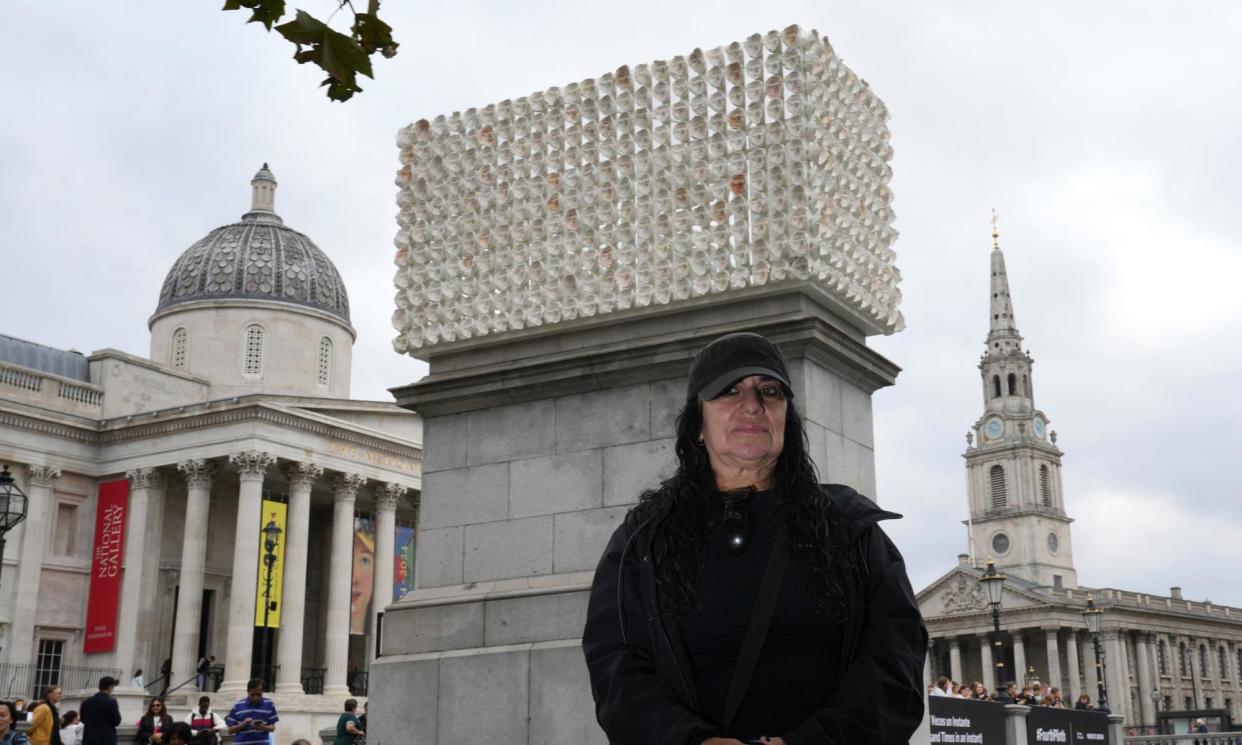Teresa Margolles’s fourth plinth review – haunting rack of faces memorialises transgender victims of violence

Look up at the latest fourth plinth sculpture and you’ll see ranks of human faces floating in the sky. They are concave receptacles of shadows – and they look so fragile. These inside-out life masks cast in plaster seem destined to be ruined by rain, pollution and pigeon droppings. The artist wants it that way.
Teresa Margolles, from Mexico, is former forensic pathologist who often makes art using the physical traces of the deceased, especially victims of murder. Her sculpture for the fourth plinth takes its form from a gruesome Aztec masterpiece, a 15th-century tower of skulls known as the Huey Tzompantli that was excavated in Mexico City. More than 600 skulls have been found cemented into it, a spectacular reminder of Aztec power and ferocity.
Margolles finds in that eerie Mesoamerican monument the inspiration for her memorial to her friend Karla, a transgender woman who was murdered in Juárez in 2015. It is also a memorial to all transgender victims of violence: 726 people from trans and non-binary communities in Britain and Mexico offered their faces to be cast in this modern-day tzompantli.
But this is by no means an instantly readable political artwork you praise or condemn in a tweet. I suspect many who pass through Trafalgar Square won’t even pick up on its precise content. They will, however, be haunted as I was by this sepulchre of the human face. You register these inverted masks like photographic negatives – which in effect they are. Some are bone white, others catch the grey of the sky, some are coloured by makeup.
Related: London’s fourth plinth artwork aims to ‘unite trans community around the world’
Margolles has created this artwork – called Mil Veces un Instante, or A Thousand Times in an Instant – at a time when femicide has reached a staggering scale in Mexico. “Eleven women are killed in this country every day,” the director of Amnesty in Mexico told the Guardian in 2022. “We have at least 20,000 women who are missing in Mexico.” Juárez, where Karla died, is one of the most dangerous places for women in the country. Shouldn’t the vulnerability of trans women in Mexico be seen as part of this wider onslaught on women? Yes, obviously – and there is nothing in Margolles’s art that conflicts with that. It is universal in its grief.
This is an archaeological artwork that brings the mystery of an excavation to modern life. One day we will all be dead. And some of the most moving objects in museums around the world are not artworks but, rather, the physical remains of the long-deceased who can be brought to startling virtual life by the forensic science in which Margolles is trained.
Looking at the clinically exact collection of living faces Margolles has assembled is as stirring as contemplating the long-dead. It’s fair to say she has a morbid streak. Life masks make everyone look like a corpse. And as corpses we are all alike. This sculpture is a call for compassion and self-recognition. We are members of the same vulnerable species. This is surely the meaning of those hollowed faces: we are seeing them from inside. There is an implicit invitation to try each mask on, to feel what it’s like in someone else’s skin.
Related: ‘Every face tells a story’: Teresa Margolles on putting 740 trans lives on the fourth plinth
That, at least, is how it feels closeup. Stand back and you see that Margolles does something no fourth plinth artist has achieved before: she’s rooted her work in London’s heritage of public sculpture. At its unveiling, one of the speakers claimed this artwork is correcting the invisibility of trans people in the city’s statues, although I don’t think we know for sure what those Victorian generals got up to behind closed doors. It is one of the silliest aspects of the fourth plinth that its contemporary works always have to be contrasted with the supposedly oppressive art of the bad old past – despite the fact that the plinth is looked down on by the 19th-century statue of visually impaired amputee Horatio Nelson.
Coming from Mexico and seeing past our local cultural squabbles, Margolles recognises and emulates the melancholy dignity of London’s older public art. From the far side of the square, her monument does not resemble an Aztec skull heap. It’s much closer to the death-white stone howitzer of Charles Sargeant Jagger’s Royal Artillery Memorial in Hyde Park. That’s how naturally this monument takes its place among London’s other memorials. Look down Whitehall and there is the Cenotaph by Edwin Lutyens, an empty tomb in the shape of a stark tower that commemorates the dead of the first world war and conflicts since.
Margolles has given London a new Cenotaph. It’s very British in look and feeling. It simply says that any death diminishes us.


